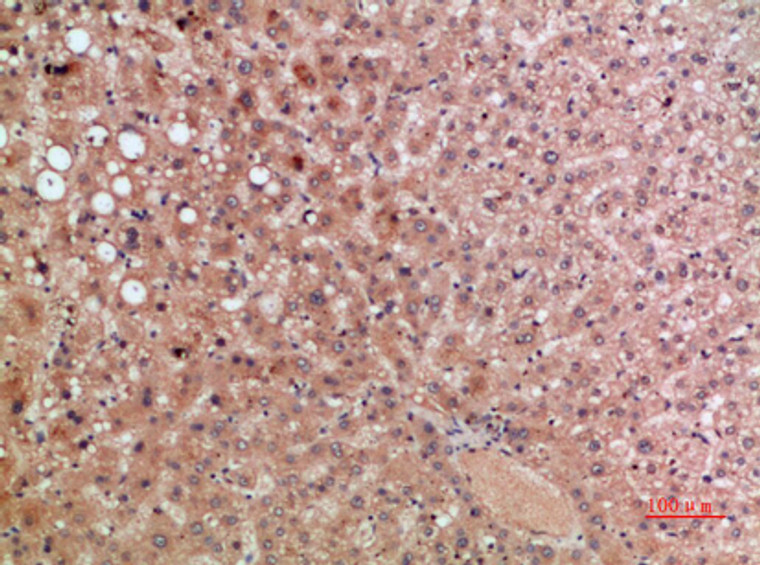| Host: |
Rabbit |
| Applications: |
WB/IHC/IF/ELISA |
| Reactivity: |
Human/Rat/Mouse |
| Note: |
STRICTLY FOR FURTHER SCIENTIFIC RESEARCH USE ONLY (RUO). MUST NOT TO BE USED IN DIAGNOSTIC OR THERAPEUTIC APPLICATIONS. |
| Short Description: |
Rabbit polyclonal antibody anti-C-C chemokine receptor type 5 (151-200 aa) is suitable for use in Western Blot, Immunohistochemistry, Immunofluorescence and ELISA research applications. |
| Clonality: |
Polyclonal |
| Conjugation: |
Unconjugated |
| Isotype: |
IgG |
| Formulation: |
Liquid in PBS containing 50% Glycerol, 0.5% BSA and 0.02% Sodium Azide. |
| Purification: |
The antibody was affinity-purified from rabbit antiserum by affinity-chromatography using epitope-specific immunogen. |
| Concentration: |
1 mg/mL |
| Dilution Range: |
WB 1:500-2000IHC-P 1:500-200ELISA 1:10000-20000IF 1:50-200 |
| Storage Instruction: |
Store at-20°C for up to 1 year from the date of receipt, and avoid repeat freeze-thaw cycles. |
| Gene Symbol: |
CCR5 |
| Gene ID: |
1234 |
| Uniprot ID: |
CCR5_HUMAN |
| Immunogen Region: |
151-200 aa |
| Specificity: |
The antibody detects endogenous CKR-5 |
| Immunogen: |
Synthetic peptide from the human protein at the amino acid range 151-200 |
| Post Translational Modifications | Sulfated on at least 2 of the N-terminal tyrosines. Sulfation contributes to the efficiency of HIV-1 entry and is required for efficient binding of the chemokines, CCL3 and CCL4. O-glycosylated, but not N-glycosylated. Ser-6 appears to be the major site even if Ser-7 may be also O-glycosylated. Also sialylated glycans present which contribute to chemokine binding. Thr-16 and Ser-17 may also be glycosylated and, if so, with small moieties such as a T-antigen. Palmitoylation in the C-terminal is important for cell surface expression, and to a lesser extent, for HIV entry. Phosphorylation on serine residues in the C-terminal is stimulated by binding CC chemokines especially by APO-RANTES. |
| Function | Receptor for a number of inflammatory CC-chemokines including CCL3/MIP-1-alpha, CCL4/MIP-1-beta and RANTES and subsequently transduces a signal by increasing the intracellular calcium ion level. May play a role in the control of granulocytic lineage proliferation or differentiation. Participates in T-lymphocyte migration to the infection site by acting as a chemotactic receptor. (Microbial infection) Acts as a coreceptor (CD4 being the primary receptor) of human immunodeficiency virus-1/HIV-1. |
| Protein Name | C-C Chemokine Receptor Type 5C-C Ckr-5Cc-Ckr-5Ccr-5Ccr5Chemr13Hiv-1 Fusion CoreceptorCd Antigen Cd195 |
| Database Links | Reactome: R-HSA-173107Reactome: R-HSA-380108Reactome: R-HSA-418594Reactome: R-HSA-6783783 |
| Cellular Localisation | Cell MembraneMulti-Pass Membrane Protein |
| Alternative Antibody Names | Anti-C-C Chemokine Receptor Type 5 antibodyAnti-C-C Ckr-5 antibodyAnti-Cc-Ckr-5 antibodyAnti-Ccr-5 antibodyAnti-Ccr5 antibodyAnti-Chemr13 antibodyAnti-Hiv-1 Fusion Coreceptor antibodyAnti-Cd Antigen Cd195 antibodyAnti-CCR5 antibodyAnti-CMKBR5 antibody |
Information sourced from Uniprot.org
12 months for antibodies. 6 months for ELISA Kits. Please see website T&Cs for further guidance









